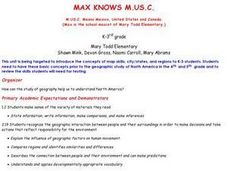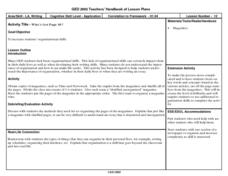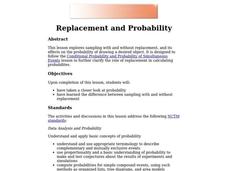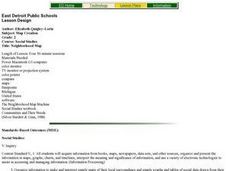Curated OER
Human Body Board Game
Young scholars research a system of the body. They write questions and answers on game cards using Microsoft Word. Students play the game they created using a game board template from Word.
Curated OER
Max Knows Mexicao, United States and Canada
Learners utilize their map skills to explore the regions of North America. They explore the physical characteristics and climates of the regions. Students label their map and prepare a presentation of their findings.
Curated OER
Vital Vitamins
Students study vitamins and who should take them and what ones to take. In this investigative instructional activity students plan a healthy diet after reviewing the types of supplements.
Curated OER
Who's Got Page 10?
Students participate in an activity that is aimed at increasing their organizational skills. They reorganize magazines that have been taken apart and scrambled.
Curated OER
Why Are Cells So Small?
Students examine the relationship between cell surface area and the ability of materials to diffuse through a cell. They participate in an experiment in which they determine which materials diffuse easier than others. They complete...
Curated OER
pH
Learners use a Colorimetric test to measure pH and gain the importance to life in an aquatic ecosystem pH is. They explore the dramatic effect pH level can have on a water body. Students test the pH level of many water samples.
Curated OER
Collecting Compost
Students observe a composting box. For this soil lesson, students create a composting bin by using a bin, newspaper, worms, and food scraps. Students create a composting food web.
Curated OER
Amazon Rainforest Conservation, Brazil
Students explore the concept of understanding the effects of disturbances in an environment. In this life science lesson, students use the game Jenga to help capture the idea of environment disturbances. Students discuss the effects of...
Curated OER
Unexpected Answers
Students consider probability problems with unexpected and surprising answers.
Curated OER
Five Themes of Geography
Young scholars explore the five themes of geography: place, region, interaction, location and movement. They create a Powerpoint presentation with separate slides for each of the themes.
Curated OER
Ecology and the Conservation of Natural Resources
Students examine the components of ecosystems. They compare and contrast an ecosystem to an aquatic ecosystem. They examine a local ecosystem and discuss its components.
Curated OER
Influences of the Enlightenment on the American Declaration of Independence
Eighth graders participate in a lesson that focuses on the study of the Declaration of Independence. The freedoms outlined in the document are discussed. Students make connections between philosophy and the writing of the Declaration.
Curated OER
Parts of a Story
Young scholars read a short fiction book and demostrate comprehension by identifying the main characters, setting, conflict, theme, and summarizing the main points. They organize the information in Inspiration and create a powerpoint to...
Curated OER
Replacement and Probability
Students explore sampling with and without replacement. They explore the effects on the probability of drawing a desired object. Students examine probability and the difference between sampling with and without replacement.
Curated OER
Landforms Slideshow
Students identify twelve different types of landforms, and create a slideshow about each landform that includes a title, pictures, definitions, conclusions and a reference page.
Curated OER
Analysis of Lobster Claw Function. An Exercise in Biomechanics
Students observe two chelae. They write three differences they observe in their notebooks. Students suggest a hypothesis which would explain these differences. They dissect the chela. Students analyze the lobster claw as a mechanical lever.
Curated OER
Rainforests of Madagascar: Role Playing and Decision Making
Students examine reasons for deforestation and become familiar with Madagascar and its culture, while describing biological and abiotic components of a rainforest, and looking at aspects that must be addressed to resolve the issue of...
Curated OER
Genetic Disorders with Cultural Roots: International Insects
Students recognize that certain populations have specific genetic disorders that could benefit or harm them in their environment, work out punnett square problems and infer offspring probabilities from results, and provide advantages and...
Curated OER
Map Creation
Second graders identify a map, symbol, key, and compass rose. Students create and print a map for teacher evaluation using the computer. Students identify the symbols on their map and orally present them to the class.
Curated OER
Investigation Xylem
Students investigate how water travels up the stem of vascular plants by using food coloring to stain the xylem of a number of different plants. They know the function of leaves, stems, and root at the end of the experiment.
Curated OER
What is Economics?
Students define economics; Explain the importance and process of making economic choices and decisions; Identify the factors of Production; Determine the goal of entrepreneurship. Students identify and describe the difficulties...
Curated OER
Scales, Scutes, and Skins
Students identify the various adaptations of reptiles and amphibians. After distinguishing between reptiles and amphibians, students discuss the ways in which their adaptations aid in their survival. They participate in a hands on...
Curated OER
Parts of a Plant- Non-Fiction Reading Comprehension
In this parts of a plant non-fiction reading worksheet, students read 2 pages that describe the parts of a plant and their jobs. They answer 10 fill in the blank and 2 short answer questions based on the reading.
Curated OER
Plant Parts
Students use "Kid Pix" to explore plants. In this science and technology lesson plan, students become familiar with plant parts and label them on a plant. Students tell the functions of each of the plant parts.

























